Nissan Pathfinder: Front Suspension - Periodic Maintenance
Front Suspension Assembly Nissan Pathfinder
Inspection
COMPONENT PART
Check the front suspension for the following:
-
Check each component for looseness or play.
-
Inspect each component for abnormal wear or damage.
Oil Leakage Inspection
-
If oil (A) does not extend beyond the spring seat (B) or upper half (C) of strut/shock absorber (1), this is slight oil seepage and the strut/shock absorber should not be replaced.
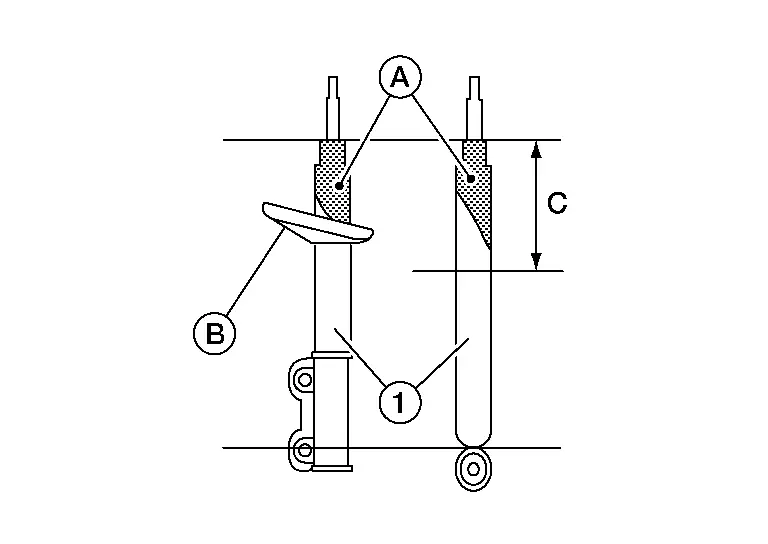
-
If oil (A) does extend beyond the spring seat (B) or upper half (C) of strut/shock absorber (1) as shown, perform the following.
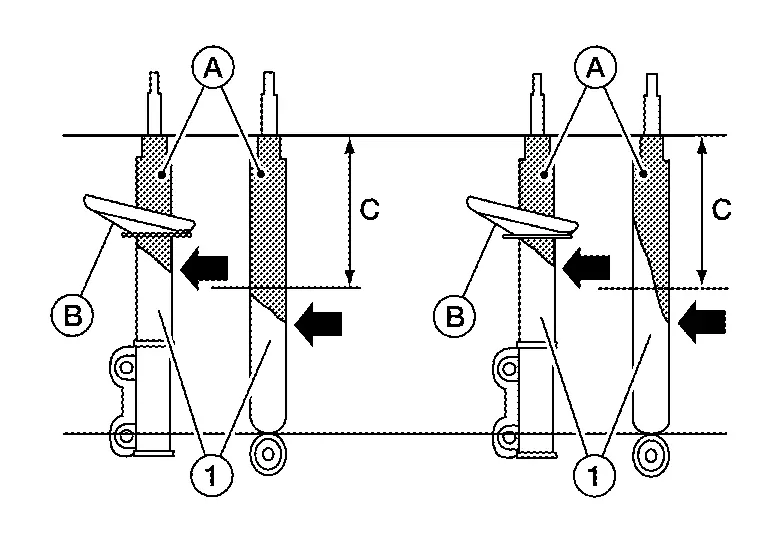
– Use a finger to touch the oil that has extended beyond the spring seat or upper half of strut/shock absorber.
– If the oil layer is thick and contains large pieces of dust and debris, replace the strut/shock absorber.
– If the oil is thin and does not contain large pieces of dust and debris, do not replace the strut/shock/ absorber.
 NOTE:
NOTE:
If strut/shock absorber leakage is diagnosed in one strut/shock absorber, do not automatically replace both sides. Replace only the leaking strut/shock absorber.
Ball Joint Axial End Play
WARNING:
When moving the front tires up and down by hand, place a jack (A) at the rear floor jack lift point to stabilize the Nissan Pathfinder vehicle or the vehicle could rock and fall off the lift resulting in serious personal injury or death.
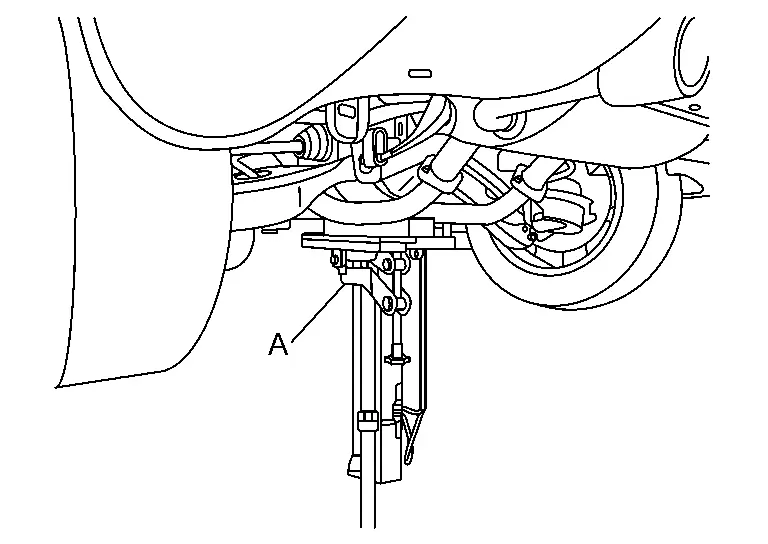
-
Set front wheels in a straight-ahead position.
-
Check ball joint boot for cracks or other damage. If there are cracks or other damage replace transverse link.
-
Move axle side of transverse link up and down by hand. Check there is no end play.
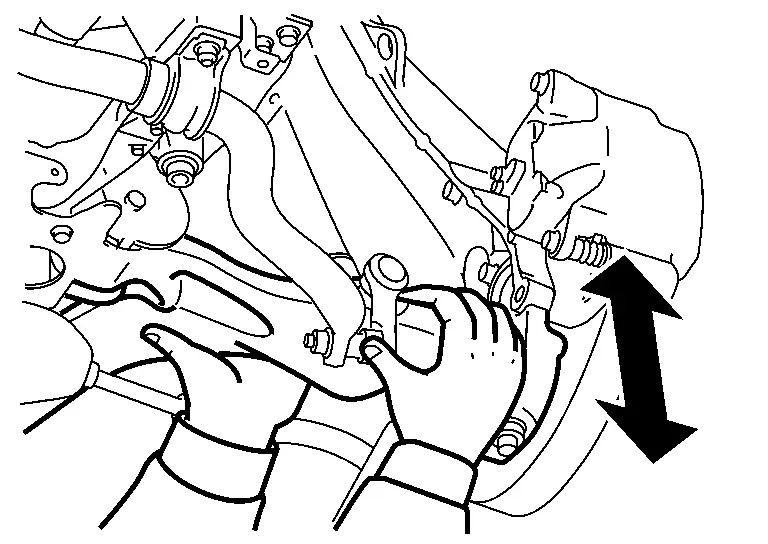
CAUTION:
-
Do not depress brake pedal when measuring.
-
Do not perform with tires on level ground.
-
Be careful not to damage ball joint boot. Do not apply excessive force.
-
Wheel Alignment Nissan Pathfinder Fifth generation
Inspection
PRELIMINARY INSPECTION
WARNING:
Always adjust the wheel alignment with the vehicle on a flat surface.
 NOTE:
NOTE:
If the wheel alignment is out of specification, inspect and replace any damaged or worn rear suspension parts before making any adjustments.
Check the following:
Check and adjust the wheel alignment with the vehicle under unladen conditions. “Unladen conditions” means that the fuel, engine coolant, and lubricants are full; the spare tire, jack, hand tools and mats are in designated positions.
Check the tires for incorrect air pressure and excessive wear. Refer to Tire Air Pressure.
Check the wheels for run out and damage. Refer to Inspection.
Check the wheel bearing axial end play. Refer to Wheel Bearing.
Check the struts for leaks or damage.
Check each mounting point of the suspension components for any excessive looseness or damage.
Check each link, arm, and the suspension member for any damage.
Check the Nissan Pathfinder vehicle height. Refer to Wheelarch Height.
GENERAL INFORMATION AND RECOMMENDATIONS
-
A four-wheel thrust alignment should be performed.
-
This type of alignment is recommended for any NISSAN Nissan Pathfinder vehicle.
-
The four-wheel “thrust” process helps ensure that the vehicle is properly aligned and the steering wheel is centered.
-
The alignment rack itself should be capable of accepting any NISSAN Nissan Pathfinder vehicle.
-
The rack should be checked to ensure that it is level.
-
-
Make sure the machine is properly calibrated.
-
Your alignment equipment should be regularly calibrated in order to give correct information.
-
Check with the manufacturer of your specific equipment for their recommended Service/Calibration Schedule.
-
ALIGNMENT PROCESS
IMPORTANT:
Use only the alignment specifications listed in this Service Manual. Refer to Wheel Alignment.
-
When displaying the alignment settings, many alignment machines use “indicators” : (Green/red, plus or minus, Go/No Go). Do not use these indicators.
-
The alignment specifications programmed into your machine that operate these indicators may not be correct.
-
This may result in an ERROR.
-
-
Most camera-type alignment machines are equipped with both “Rolling Compensation” method and optional “Jacking Compensation” method to “compensate” the alignment targets or head units. “Rolling Compensation” is the preferred method.
-
If using the “Rolling Compensation” method, after installing the alignment targets or head units, push or pull on the rear wheel to move the Nissan Pathfinder vehicle. Do not push or pull on the vehicle body.
-
If using the “Jacking Compensation” method, after installing the alignment targets or head units, raise the Nissan Pathfinder vehicle and rotate the wheels 1/2 turn both ways.
 NOTE:
NOTE:
Do not use the “Rolling Compensation” method if you are using sensor-type alignment equipment.
-
Follow all instructions for the alignment machine you're using for more information.
-
CAMBER, CASTER AND KINGPIN INCLINATION ANGLES INSPECTION
-
Camber, caster, kingpin inclination angles cannot be adjusted.
-
Before inspection, set the front wheels onto a turning radius gauge. Set the rear wheels onto a pad that has the same height so the Nissan Pathfinder vehicle will remain horizontal.
TOTAL TOE-IN INSPECTION
Measure the total toe-in using the following procedure.
WARNING:
-
Always perform the following procedure on a flat surface.
-
Make sure that no person is in front of Nissan Pathfinder vehicle before pushing it.
Bounce the front of vehicle up and down to stabilize the vehicle height (posture).
Push on the rear wheel to move the Nissan Pathfinder vehicle straight ahead about 5 m (16 ft).
Put a mark on base line of the tread (B) of both tires at the same height of hub center (A) . These are measuring points (C).
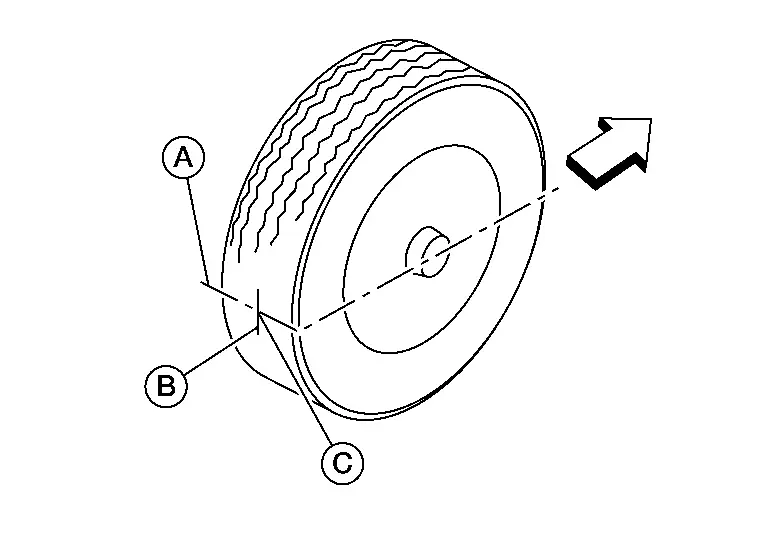
 |
: Front |
Measure the distance (A) from the rear side.
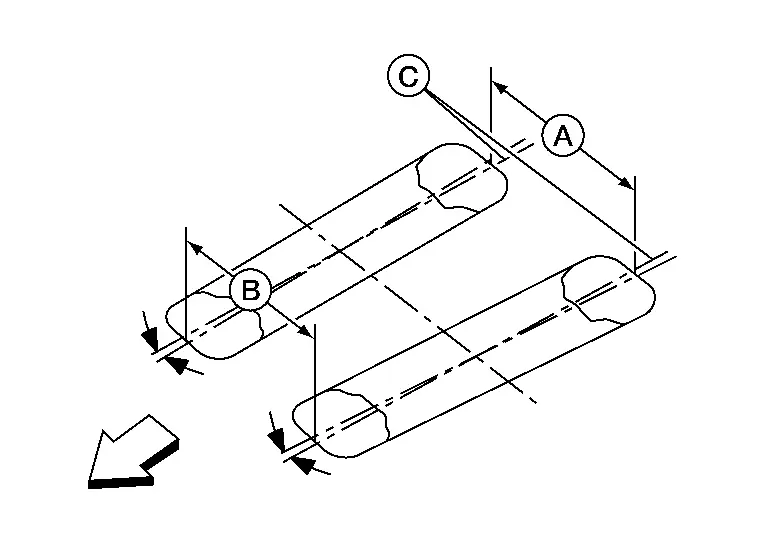
 NOTE:
NOTE:
Lines parallel to center line of body (C)
 |
: Front |
Push on the rear wheel to move the Nissan Pathfinder vehicle slowly ahead and to rotate the wheels 180 degrees (1/2 turn).
CAUTION:
If the wheels have rotated more than 180 degrees (1/2 turn), try the above procedure again from the beginning. Do not push Nissan Pathfinder vehicle backward.
Measure the distance (B) from the front side.
Use the formula below to calculate total toe-in.
| Total toe-in formula | : A - B |
| Total toe-in specification | : Refer to Wheel Alignment. |
-
If the total toe-in is outside the specification, adjust the total toe-in. Refer to Wheel Alignment.
Adjustment
TOE-IN ADJUSTMENT
-
Loosen the inner socket locknut (A).
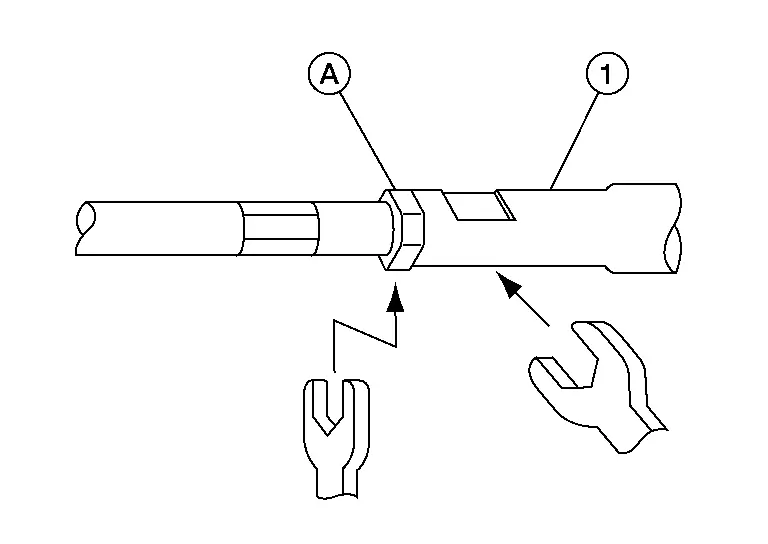
CAUTION:
To prevent damage, hold outer socket (1) across flats using suitable tool while loosening inner socket lock nut.
-
Adjust the toe using the inner socket.
CAUTION:
Always evenly adjust toe using LH and RH inner sockets alternately and adjust the total toe-in to the standard.
Total toe-in : Refer to Wheel Alignment. -
Tighten the inner socket locknut. Refer to Exploded View.
CAUTION:
-
To prevent damage, hold outer socket across flats using suitable tool while tightening inner socket lock nut.
-
Inspect to make sure no boot deformation has occurred during toe-in adjustment. Adjust boot as necessary.
-
-
After toe-in adjustment, adjust neutral position of steering angle sensor. Refer to Description.

Nissan Pathfinder (R53) 2022-2025 Service Manual
Periodic Maintenance
Contact Us
Nissan Pathfinder Info Center
Email: info@nipathfinder.com
Phone: +1 (800) 123-4567
Address: 123 Pathfinder Blvd, Nashville, TN 37214, USA
Working Hours: Mon–Fri, 9:00 AM – 5:00 PM (EST)
